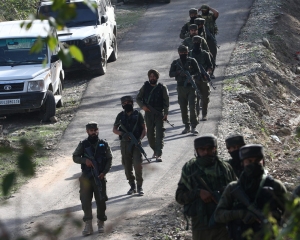Post Diwali, an analysis by the Delhi Pollution Control Committee (DPCC) revealed the concentration of fine, lung-damaging particulate matter PM2.5 and PM10 increased by 45 per cent and 33 per cent respectively as compared to last year.
The analysis also highlighted that nearly all air quality monitoring stations in the national capital recorded increased pollution levels on Diwali as compared to the previous year. The analysis showed Delhi's 24-hour average PM10 concentration on Diwali (Sunday) stood at 430 micrograms per cubic meter, an increase from 322 micrograms per cubic meter last year, and 748 micrograms per cubic meter in 2021. On Monday, the AQI stood at 275 (poor category) at 7 am and gradually rose to 322 by 12 noon. After the air quality in Delhi took a turn for the worse the morning after Diwali, the forecast indicates that it is set to deteriorate further and hit the ‘severe’ category once again on Tuesday and Wednesday.
The air quality index is likely to reach in severe category from November 14m to 15. It has also predicted that the air quality is likely to remain in Severe to Very Poor category for the next six days. The DPCC report emphasized that all gaseous pollutants, including ammonia, sulphur dioxide, nitrogen dioxide, carbon monoxide, ozone, and benzene, remained within prescribed standards.
The city recorded a 24-hour average PM2.5 concentration of 314 micrograms per cubic meter, compared to 217 micrograms per cubic meter last year and 607 micrograms per cubic meter in 2021.
The Analysis report says PM2.5 pollution levels at the Jawaharlal Nehru Stadium soared to 1,423 micrograms per cubic metre by 2 am before it gradually came down to 101 micrograms per cubic metre by 12 noon due to rise in temperatures. The PM2.5 concentration at Okhla stood at 1,629 micrograms per cubic metre at 1 am and dipped to 157 micrograms per cubic metre by 12 noon. At 12 midnight, the air quality monitoring station at Anand Vihar recorded a PM2.5 concentration of 1,985 micrograms per cubic metre, the data showed.
The data revealed that, except for Alipur, Patparganj, Najafgarh, Karni Singh Shooting Range, and Okhla, all stations (total 24) observed an increase in the concentration of PM10 in 2023 compared to 2022.
It showed that all stations, with the exception of those at Sri Aurobindo Marg, Vivek Vihar, and Karni Singh Shooting Range, witnessed an increase in the concentration of PM2.5.
The DPCC said that all gaseous pollutants, including ammonia, sulphur dioxide, nitrogen dioxide, carbon monoxide, ozone, and benzene, were found to be within the prescribed standards.
Real Time Noise Monitoring was undertaken at 31 locations in Delhi during Diwali Day (12 Nov 2023), the range was observed with minimum value of 53.7 dB(A) (Najafgarh) and maximum value of 84.5 dB(A) (Karol Bagh) on Diwali Day. Before Diwali day (06 Nov 2023), the range was observed with minimum value of 44.9 dB(A) (Najafgarh) and maximum value of 74.7 dB(A) (Karol Bagh). The analysis further stated that six major Gaseous Pollutants are measured that are Ammonia, SO2, NO2, CO, O3 & Benzene. All the pollutants were within the National Ambient Air Quality Standard (NAAQS)
Within Delhi, pollution levels reached the 'severe' category (AQI between 400 and 450) in some areas, including RK Puram (402), Jahangirpuri (419), Bawana (407) and Mundka (403). The concentration of PM2.5, fine particulate matter that can penetrate deep into the respiratory system and trigger respiratory problems, exceeded the safe limit of 60 micrograms per cubic metre by six to seven times in these areas.
Delhi recorded an AQI of 312 on Diwali last year, 382 in 2021, 414 in 2020, 337 in 2019, 281 in 2018, 319 in 2017 and 431 in 2016, according to Central Pollution Control Board data. The city's AQI a day after Diwali stood at 360 in 2015; 445 in 2016; 403 in 2017; 390 in 2018; 368 in 2019; 435 in 2020, 462 in 2021 and 303 in 2022.
In the 24 hours ending at 4 pm on Monday, the AQI rose from 186 to 349 in Ghaziabad, from 193 to 349 in Gurugram, from 189 to 363 in Noida, from 165 to 342 in Greater Noida, and from 172 to 370 in Faridabad with intense firecracker bursting being reported in these places. Delhi recorded its lowest minimum temperature of the season so far early on Monday—11.8 degrees Celsius, and the minimum temperature is likely to remain around 11 or 12 degrees from Tuesday to Thursday, according to the India Meteorological Department (IMD) forecast. Calm conditions are also likely to persist in the morning hours from Tuesday to Thursday, as indicated by the Air Quality Early Warning System.























